Realistic artificial grass landscaping is a cost-effective, low-maintenance alternative to natural grass for both residential and commercial properties. It replicates the appearance and feel of real grass, enhancing curb appeal while eliminating high upkeep costs. Selection of appropriate synthetic turf types, proper site preparation, and efficient installation techniques are crucial. Maintenance involves regular cleaning, inspection, and occasional deep watering to keep the turf vibrant and durable. By choosing realistic artificial grass, property owners can enjoy year-round beauty with reduced water bills and environmental impact.
“Discover the secrets to cost-effective artificial grass installation and transform your outdoor space. This comprehensive guide explores the benefits of realistic artificial grass landscaping, helping you make informed decisions. Learn how to choose the right type for your project and master the step-by-step installation process.
From maintenance tips to ensuring longevity and maximizing cost savings, this article covers it all. Uncover why realistic artificial grass is a game-changer for both aesthetics and budget-conscious homeowners.”
- Understanding Cost-Effective Artificial Grass Installation
- Benefits of Realistic Artificial Grass Landscaping
- Choosing the Right Type of Artificial Grass for Your Project
- Step-by-Step Guide to Efficient Artificial Grass Installation
- Maintenance Tips for Longevity and Cost Savings
Understanding Cost-Effective Artificial Grass Installation

In today’s market, cost-effective artificial grass installation has become a popular choice for both residential and commercial properties, offering an attractive and low-maintenance alternative to natural grass landscaping. The key to achieving realistic artificial grass lies in understanding the various components and techniques involved. This begins with selecting high-quality synthetic turf that replicates the appearance and feel of real grass, ensuring durability and a natural look.
Next, proper preparation of the installation site is crucial. This includes removing existing vegetation, leveling the ground, and installing an efficient drainage system to prevent water accumulation. A layer of compacted base material provides a sturdy foundation, enhancing the turf’s longevity. By combining these elements effectively, you can create a stunning, realistic artificial grass landscape that offers year-round beauty without the high upkeep costs associated with natural grass.
Benefits of Realistic Artificial Grass Landscaping

Realistic artificial grass landscaping offers a myriad of benefits, transforming outdoor spaces into vibrant oases that require minimal upkeep. One of the key advantages is its ability to mimic the appearance and texture of natural grass, providing an aesthetically pleasing alternative for yards, sports fields, and commercial properties alike. This realistic mimicry not only enhances curb appeal but also creates comfortable, safe play areas for children and pets.
Furthermore, compared to traditional lawn maintenance, artificial grass installation proves highly cost-effective over time. It eliminates the need for watering, fertilizing, mowing, and other labor-intensive tasks, significantly reducing water bills and saving homeowners and businesses a considerable amount of money. This low-maintenance nature also contributes to environmental sustainability by minimizing chemical usage and reducing waste associated with lawn care products.
Choosing the Right Type of Artificial Grass for Your Project

When considering cost-effective artificial grass installation, selecting the right type is paramount. The market offers a diverse range of options, from low-pile to high-density realistic artificial grass, each with unique characteristics suitable for different applications. For areas with heavy foot traffic, such as playgrounds or sports fields, durable, high-密度 varieties with robust fibres are ideal. These offer superior performance and longevity, ensuring your investment holds up under constant use.
In contrast, for more decorative or low-traffic spaces like gardens or residential front yards, lower pile heights can mimic the look of natural grass while being easier on the wallet. Realistic artificial grass landscaping options come in various textures and colours, allowing you to create visually appealing outdoor spaces that require minimal maintenance. This versatility makes them a popular choice for homeowners looking to enhance their curb appeal without breaking the bank.
Step-by-Step Guide to Efficient Artificial Grass Installation

Step-by-Step Guide to Efficient Artificial Grass Installation
The first step in cost-effective artificial grass installation is preparation. Clear the area, removing any existing vegetation, debris, and obstructions. Level the ground, ensuring it’s even, to provide a solid base for your realistic artificial grass landscaping. This involves filling in any depressions or uneven spots with topsoil or aggregate material. Once the surface is ready, lay down a high-quality weed barrier fabric to prevent unwanted growth.
Next, install the drainage layer, which allows excess water to flow through while keeping the artificial grass dry. Place your chosen artificial grass product over the drainage layer, ensuring proper alignment and cutting it to fit odd spaces. Use a specialized adhesive or infill system to secure the grass blades in place. After installation, thoroughly water the artificial grass to activate any adhesives or infills used, ensuring a lush and vibrant look that mimics natural landscapes.
Maintenance Tips for Longevity and Cost Savings

Proper maintenance is key to ensuring your realistic artificial grass landscaping remains in top condition, extending its lifespan and delivering ongoing cost savings. Start with regular cleaning to prevent debris buildup, which can block sunlight and cause fading. Use a soft brush or vacuum designed for synthetic turf to gently remove dust, leaves, and other particles. Avoid aggressive brushing that could damage the blades.
Next, inspect your artificial grass regularly for any signs of wear or damage. Address issues promptly—trim overgrown edges, patch small holes or rips, and keep drainage systems clear. Proper hydration is crucial; while synthetic turf requires less water than natural grass, occasional deep watering helps maintain its texture and color. Following these simple maintenance tips will not only keep your artificial grass looking fresh but also contribute to significant long-term savings on costly replacement and repair expenses.
Realistic artificial grass landscaping offers a cost-effective solution for both residential and commercial spaces, eliminating the need for traditional lawn maintenance. By choosing the right type of artificial grass and following efficient installation and maintenance practices, you can enjoy a lush, vibrant outdoor space that saves money and time in the long run. Implement these strategies to transform your outdoor area into a low-maintenance, visually appealing haven without breaking the bank.
